🦋 Ein Traum │ A dream 🐛
Brauner Bär ■ Great tiger moth
Arctia caja (Linnaeus, 1758)
Der braune Bär ist ein Nachtfalter aus der Familie der Bärenspinner (Arctiinae). Er fliegt ausschließlich nach Mitternacht und wird deshalb nur sehr selten beobachtet. Die Raupe kann man häufiger in der Natur beobachten. Leider waren alle Versuche diesen Falter zu züchten erfolglos, da die Raupen immer parasitiert waren. Ein Entomologe hatte von meinen Misserfolgen gehört und mir im Oktober einige Raupen geschickt. Einen Teil dieser Raupen züchte ich als so genannte Treibzucht bis zum kommenden Sommer durch. Ein Großteil der Raupen überwintert als Jungraupe in der freien Natur und geht in eine Diapause, in der die Raupe über den Winter keine Nahrung zu sich nimmt. Erst im späten Frühling beginnt diese erneut zu fressen, um sich im Juni zu verpuppen. Der Schmetterling schlüpft dann in den heißen Sommermonaten Juli und August.
The great tiger moth is a moth from the family of Arctiinae. It only flies after midnight and is therefore rarely seen. The caterpillar can be seen more often in nature. Unfortunately, all attempts to breed this moths were unsuccessful, because the caterpillars were always parasitized. An entomologist had heard about my failures and sent me some caterpillars in October. A part of these caterpillars I breed as so called Treibzucht (I don't know the name in English) through to the coming summer. A large part of the caterpillars hibernate as young caterpillars in the wild and go into a wintersleep in which the caterpillar does not eat any food during the winter. Only in late spring does the caterpillar start to eat again and pupate in June. The butterfly then hatches in the hot summer months of July and August.
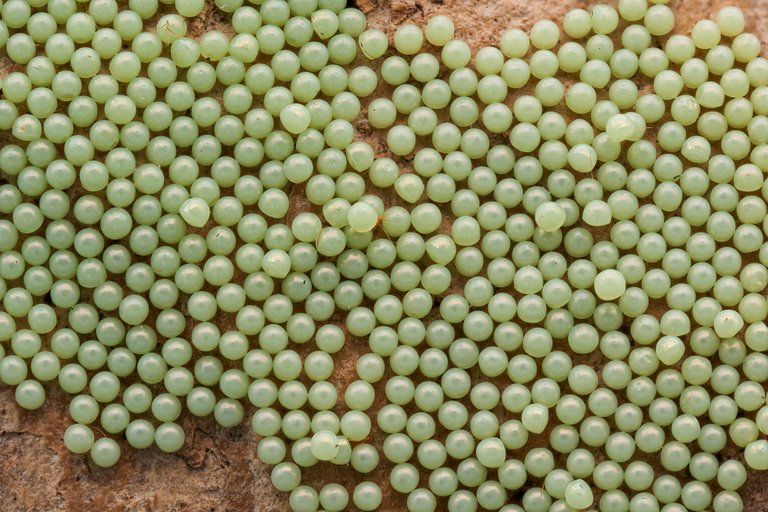
▲ Click on the image for full resolution ▲
Nach der Kopula legt das Weibchen 300-400 Eier an unterschiedliche Pflanzen in einem Eispiegel ab. Die Eier sind blassgrün und ca. 0,3 mm groß. Sie werden mit einem wasserfesten Klebstoff angeheftet. Die Eier sind so in der Natur, gegen Feuchtigkeit und Regen geschützt. Im Ei entwickelt sich die Raupe. Nach ca. acht Tagen ist die Entwicklung der Raupe abgeschlossen und das Ei färbt sich dunkel. Ein Zeichen dafür, das die Raupe ihre Eihülle in Kürze verlassen wird.
After the copula, the female lays 300-400 eggs at different plants in an ice-mirror. The eggs are pale green and about 0.3 mm in size. They are attached with a waterproof adhesive. The eggs are protected in nature against humidity and rain. The caterpillar develops in the egg. After about eight days the development of the caterpillar is completed and the egg turns dark. This shows that the caterpillar will soon leave its egg shell.
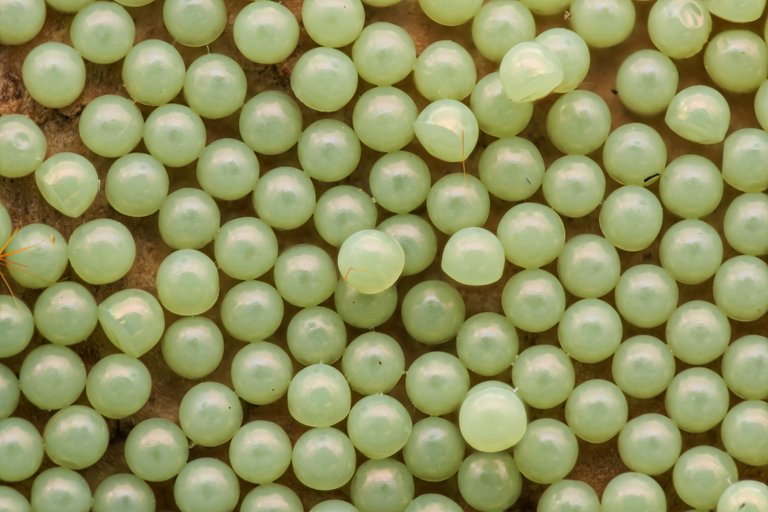
▲ Click on the image for full resolution ▲
Ist die Entwicklung der Raupe im Ei abgeschlossen, frisst sie von innen eine Öffnung durch die Eihülle und verlässt das Ei. Das alles kostet Kraft, so dass die nur 2-3 mm große Raupe erst mal eine Pause benötigt, bevor sie mit der Nahrungsaufnahme beginnt. In der nachfolgenden Aufnahme kann man die unterschiedlichen Stadien der Eier erkennen. Hat die Raupe ihre Eihülle verlassen sind die Eier hell und die Fraßöffnung wird deutlich sichtbar.
Once the development of the caterpillar in the egg is complete, it eats from the inside an opening through the egg shell and leaves the egg. This all costs energy, so that the caterpillar, which is only 2-3 mm in size, first needs a break before beginning to eat. In the following picture you can see the different stages of the eggs. Once the caterpillar has left its egg shell, the eggs are light and the feeding hole is clearly visible.
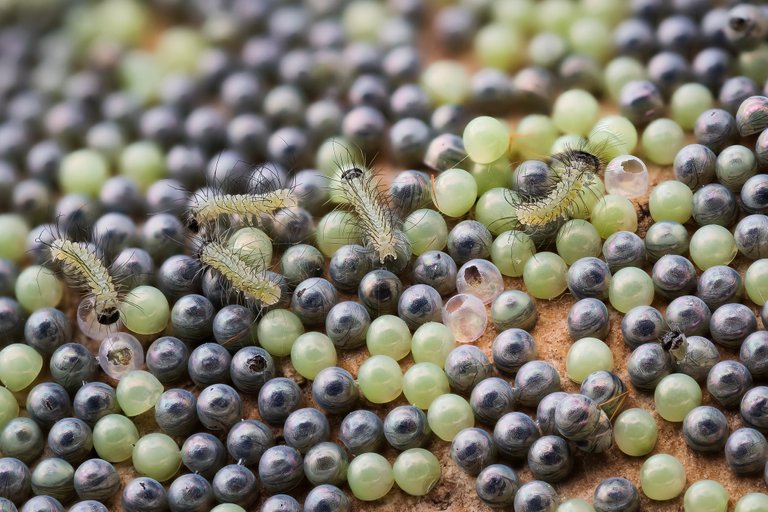
▲ Click on the image for full resolution ▲
Die Raupe des braunen Bär wird unter Züchtern, auch als Wildschwein der Raupen bezeichnet. Das mag daran liegen, dass sie eine Vielzahl an Futterpflanzen als Nahrung akzeptiert. Ich habe den jungen Raupen Löwenzahn, Spitzwegerich und Ampfer gereicht, von denen sie Löwenzahn am besten angenommen haben. Aber auch an den anderen genannten Blättern haben sie gefressen. Wichtig ist, dass die Futterpflanzen nicht nass verfüttert werden, da Nässe bei den Raupen zu Durchfall führen kann. Sie entwickeln ordentlichen Appetit so dass täglich frisches Futter notwendig ist. Schnell wird der kleinen Raupe ihre Haut zu eng und sie muss diese abstreifen um weiter zu wachsen. Dabei verändert sich auch ihr Erscheinungsbild wie man nachfolgend erkennen kann.
The caterpillar of the great tiger moth is called among breeders, also as wild boar of the caterpillars. This may be due to the fact that it accepts a large number of forage plants as food. I have served dandelion, ribwort and sorrel to the young caterpillars, of which they have best accepted dandelion. But they also ate the other leaves mentioned above. It is important that the food plants are not fed wet, as wetness can lead to diarrhoea in the caterpillars. They develop a good appetite so that fresh food is necessary every day. The caterpillar's skin quickly becomes too tight and it has to strip it off to continue growing. This also changes the appearance of the caterpillar as you can see below.
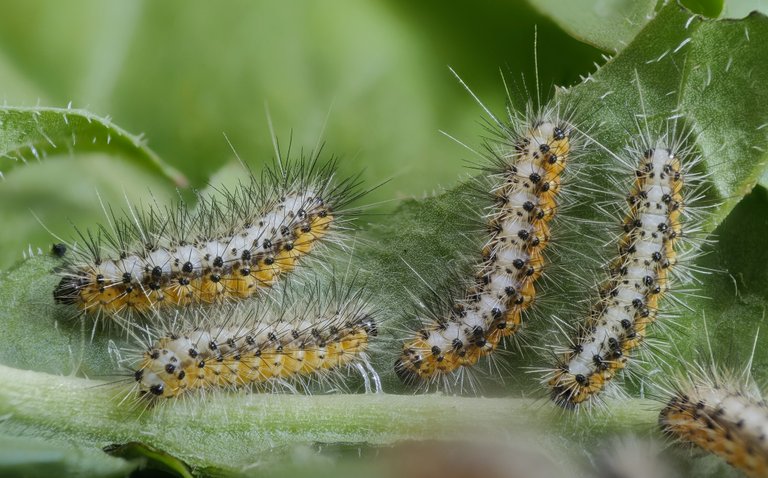
▲ Click on the image for full resolution ▲
Die langen Haare der Raupe sind ein Schutz gegen Fressfeinde. Menschen reagieren auf den Kontakt mit den Haaren unterschiedlich. Bei sensiblen Personen, können die Haare Hautreaktionen verursachen. Man sollte besser den direkten Kontakt mit der Raupe meiden. Das gilt im Übrigen für alle behaarten Raupen. Ich persönlich hatte schon mehrmals Kontakt mit den Haaren und bisher keine Probleme damit.
The long hair of the caterpillar is a protection against predators. People react differently to contact with the hair. In sensitive individuals, the hair can cause skin reactions. It is better to avoid direct contact with the caterpillar. This also applies to all hairy caterpillars. Personally, I have had contact with the hair several times and have had no problems with it so far.

▲ Click on the image for full resolution ▲
Bei Gefahr rollt sich die Raupe zusammen, um ihre verletzliche Unterseite besser zu schützen. Das alles nützt ihr wenig wenn eine Schlupfwespe mit ihrem Legestachel ihre Eier in die Raupe legt. Dieser Parasit ernährt sich von der Raupe und frisst sie von innen auf. Das war auch der Grund, warum mir zuvor noch nie eine erfolgreiche Zucht gelungen ist. Die Raupen waren alle parasitiert. So wird aus der Raupe kein Schmetterling, sondern aus ihr schlüpft eine Schlupfwespe. Der braune Bär ist ein so genannter Reproduktionsstratege, das bedeutet, dass er viele Nachkommen erzeugt, von denen letztendlich nur ca. 1-2% bis zum fertigen Schmetterling überleben. Dazwischen dient er, vielen weiteren Arten als Nahrungsquelle. Nicht nur Insekten reihen sich in diese Nahrungskette ein, auch Prädatoren wie Vögel, schätzen die nahrhaften Raupen mit denen sie Ihre Jungvögel füttern. Durch die Zucht von Schmetterlingen gewinnt man einen ganz andere Sicht auf die Natur, ihre Vielfalt und alles was sie bewirkt.
In case of danger, the caterpillar rolls up to better protect its vulnerable underside. All this is of little use to you if a ichneumon fly lays its eggs in the caterpillar with its laying spine. This parasite feeds on the caterpillar and eats it from the inside. That was also the reason why I have never succeeded in breeding a parasite successfully before. The caterpillars were all parasitized. So the caterpillar does not become a butterfly, but hatches into a ichneumon fly. The great tiger moth is a so-called reproductive strategist, which means that it produces many offspring, of which only 1-2% survive to the finished moth. In between it serves as a food source for many other species. Not only insects join this food chain, also predators like birds appreciate the nutritious caterpillars with which they feed their young birds. Breeding moths gives you a completely different view of nature, its diversity and everything it does.
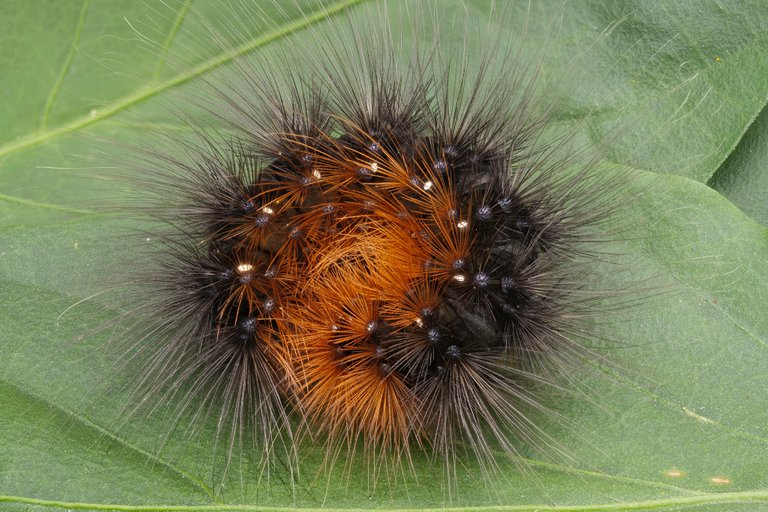
▲ Click on the image for full resolution ▲
Nachdem sich die Raupe fünf mal gehäutet hat, ist sie erwachsen. Jetzt stellt sie ihre Nahrungsaufnahme ein. Nervös krabbelt sie umher und sucht sich eine geeignete Stelle, um sich zwischen Laub zu verpuppen. Dort spinnt sich die Raupe in ein loses Gespinst ein, in der sich die Puppe entwickelt. Diese Entwicklung dauert ca. 3 Wochen. Dann ist die Verwandlung (Metamorphose) von der Raupe zum Schmetterling abgeschlossen. Jetzt ist der Falter bereit für sein neues Leben und sprengt die Puppenhülle, um aus ihr heraus zu kriechen.
After the caterpillar has skinned itself five times, it has grown up. Now she stops eating. Nervously she crawls around and looks for a suitable place to pupate between leaves. There the caterpillar weaves itself into a loose web in which the pupa develops. This development takes about 3 weeks. Then the transformation (metamorphosis) from the caterpillar to the moth is completed. Now the moth is ready for its new life and bursts the pupa shell to crawl out of it.
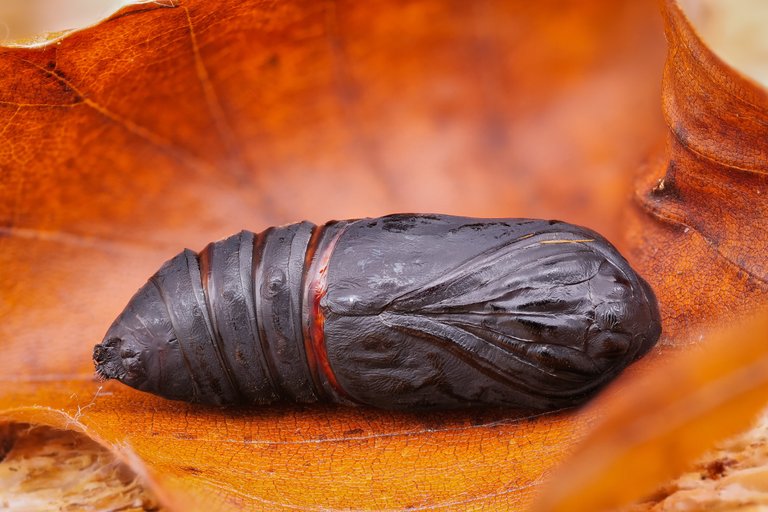
▲ Click on the image for full resolution ▲
Die Flügel sind zu Beginn noch nicht voll entwickelt und entfalten sich innerhalb einer Stunde. Dabei pumpt der Schmetterling Blut in die Adern der Flügel. Dabei hat er die Flügel zusammengeklappt, um sie nach vollständiger Entwicklung zu entfalten. Jetzt zeigt dieser Schmetterling seine wahre Schönheit. Die schokoladenbraune Flügeloberseite mit ihren cremefarbenen Maserungen, die je nach Falter auch variieren kann, ist wunderschön anzuschauen.
The wings are not fully developed at the beginning and unfold within an hour. The moth pumps blood into the veins of the wings. It has collapsed the wings to unfold them after complete development. Now this moth shows its true beauty. The chocolate brown top of the wings with its creamy grain, which can vary depending on the moth, is beautiful to look at.
♀
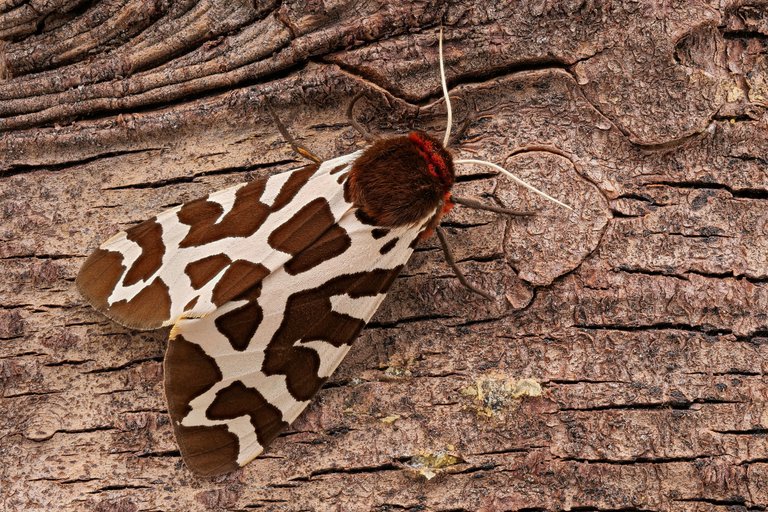
▲ Click on the image for full resolution ▲
Öffnet der Schmetterling seine Vorderflügel, leuchten die orangen Hinterflügel mit ihren dunkel blauen Punkten. Welch ein grandioser Anblick. Ein Meisterwerk der Natur, welches uns Menschen verzaubert. Aus Sicht eines Vogels schaut dieses Design ganz aders aus. Die Farbe Orange signalisiert Gefahr. Die blauen Augen wirken bedrohlich und erschrecken den Prädator, so dass er die Flucht ergreift. Einfach grandios, welch ein faszinierendes Wesen die Natur hier erschaffen hat.
When the moth opens its fore wings, the orange hind wings shine with their dark blue dots. What a magnificent sight. A masterpiece of nature, which enchants us humans. From a bird's point of view, this design looks very veined. The colour orange signals danger. The blue eyes appear threatening and frighten the predator so that he takes flight. Simply magnificent, what a fascinating creature nature has created here.
♂
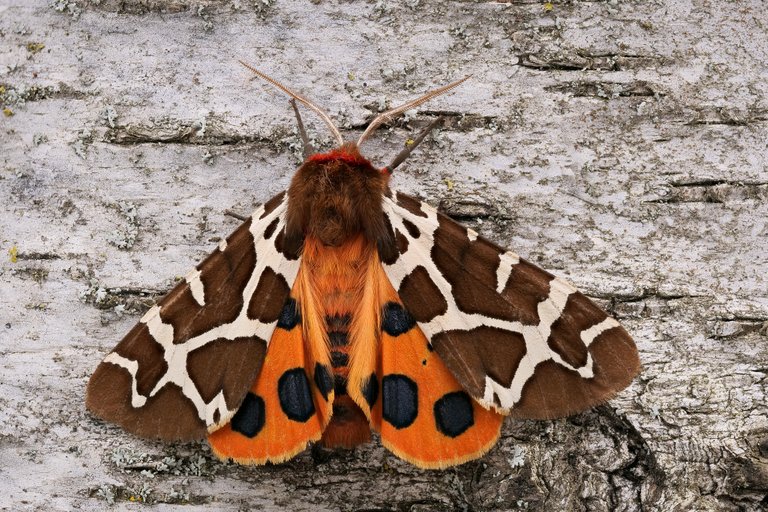
▲ Click on the image for full resolution ▲
Deutlich sind die gefächerten Fühler des Männchens erkennbar. Bei den Weibchen kann man diese bei genauerer Betrachtung auch erkennen. Allerdings sind diese bei weitem nicht so ausgeprägt wie beim Männchen. Mit dem Fächer kann ein Männchen das Weibchen auf große Entfernung wahrnehmen und dieses gezielt anfliegen. Der braune Bär nimmt als Schmetterling keine Nahrung zu sich. Sein Leben dient einzig der Fortpflanzung. Nach der Kopula und der Eiablage durch das Weibchen lebt der Falter nur noch wenige Tage. Wenn die neue Generation auf dem Weg zum erwachsen Falter ist, stirbt der braune Bär. Sein Leben dient einzig der Fortpflanzung und zaubert dem Menschen, der genauer hinschaut ein Lächeln ins Gesicht.
The fanned feelers of the male are clearly recognizable. With the females one can recognize these also with closer inspection, however this is by far not as pronounced as with the male. With the fan, a male can perceive the female at a great distance and approach it in a targeted manner. The great tiger moth does not eat any food as a moth. Its life serves only the reproduction. After the copula and the egg-laying by the female, the moth lives only few days. If the new generation is on the way to the adult moth, the Great tiger dies. His life serves only reproduction and conjures up a smile on the face of the person who looks closer.
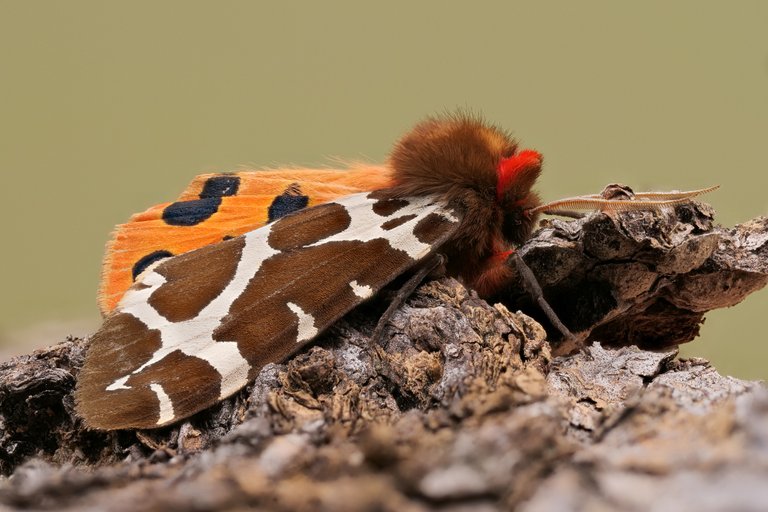
▲ Click on the image for full resolution ▲
Hier noch ein Link zu meinem ersten Beitrag über diesen zauberhaften Nachtfalter:
https://steempeak.com/lepidoptera/@faltermann/nach-langer-suche-after-a-long-search
Here is a link to my first article about this magical moths:
https://steempeak.com/lepidoptera/@faltermann/nach-langer-suche-after-a-long-search
| Category: | Macro |
| Camera: | Panasonic Lumix DC-G9 |
| Lens: | Olympus M.Zuiko Digital ED 60mm 1: 2.8 Macro + Raynox DCR 250 |
| Location: | Germany, Bavaria, Lower Franconia, Kreuzwertheim |
Wenn dir mein Beitrag gefällt, freue ich mich über deine Nachricht.
Herzlichen Dank und viele Grüße vom @faltermann 🐛
If you like my contribution, I am looking forward to your message.
Many thanks and greetings from Germany 🦋
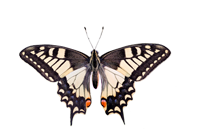
Wow. This is such a cool post. The pictures of the eggs are really interesting, they are like a cross between grapes and pearls. The caterpillars and adult moths are so beautiful but honestly the photo of the pupa might be my favorite. I am glad you successfully raised them this time so we could see such an amazing post!
@tipu curate
Upvoted 👌 (Mana: 20/35 - need recharge?)
Many thanks for your support!
What great feedback. I am happy that you like my contribution. Thank you very much and best regards from Germany.
This post was shared in the Curation Collective Discord community for curators, and upvoted and resteemed by the @c-squared community account after manual review.
@c-squared runs a community witness. Please consider using one of your witness votes on us here
Thanks, for your great support!
Pilzsaison vorbei...
Schöne Bilder
Nein, nicht wirklich. Auch im Winter findet man noch Pilze. Die Suche gestaltet sich aber wesentlich schwieriger.
Beautiful photography gentleman
Posted using Partiko Android
Thanks my friend :)
Sagenhafter Bericht. In freier Natur könnte man das nur schwer beobachten was du uns hier zeigst, danke dafür.
Eine solchen Dokumentation ist in der freue Natur so gut wie nie möglich. Die Zucht ermöglicht einem Einblicke die normal verborgen bleiben. Für mich war diese Dokumentation wirklich ein Highlight in 2019.
Vielen Dank und noch einen schönen Abend :)
wow, dann hab ich ja richtig Glück.. zumindest manchmal
Ein bisschen Glück gehört immer mit dazu! 😁
Klasse von Ei bis Falterstudie. Resteemed :-)
Vorbereitet hatte ich den Beitrag schon einige Zeit. Es haben mir jedoch noch Bilder gefehlt. Diese konnte ich in den vergangenen Tagen ergänzen. Ich wollte die Entwicklung nahtlos dokumentieren. Es war mir eine Herzensangelegenheit.
Danke!
Es ist wirklich schön,das mal zu sehen....Danke! (und...Resteemed!)
Das freut mich sehr. Vielen Dank und eine angenehme Woche für dich 🦋
Posted using Partiko Android
!COFFEEA
Toll!
Herzlichen Dank!
I hope I find same bugs also in next summer 😁😊 cool post I was like it.
I would be happy and also you could publish an article about this butterfly. In any case, I'll keep my fingers crossed that you'll meet it sometime 🤞🦋
Posted using Partiko Android
Thank you !! :) ... I try get :)
Thank you very much!
They truly are fascinating creatures! The markings of this particular one remind me of a cow haha! Metamorphosis was probably one of the few things I enjoyed learning about in primary school! And your photos are exceptional!
Thank you very much for your feedback. It is always amazing what other people see in my pictures. Your comparison with the cow is not absurd.
I am glad that you like my contribution. 🦋
Posted using Partiko Android
hehehe yes it is indeed! And it was my pleasure x
This post was curated by @theluvbug
and has received an upvote and a resteem to hopefully generate some ❤ extra love ❤ for your post!
JOIN ME ON TWITTER
In Proud Collaboration with The Power House Creatives
and their founder @jaynie
JOIN US HERE
FOLLOW US ON TWITTER
Many thanks for your support!
Du hast ein kleines Upvote von unserem Curation – Support – Reblog Account erhalten. Dieser wurde per Hand erteilt und nicht von einem Bot.
Du findest uns im Discord unter https://discord.gg/Uee9wDB
Super, Ich freue mich! Vielen Dank für deine Unterstützung 🦋
Posted using Partiko Android
Congratulations @faltermann! You have completed the following achievement on the Steem blockchain and have been rewarded with new badge(s) :
You can view your badges on your Steem Board and compare to others on the Steem Ranking
If you no longer want to receive notifications, reply to this comment with the word
STOPTo support your work, I also upvoted your post!
Many thanks for your support!
Posted using Partiko Android
You're welcome @faltermann
!invest_vote und #CC
Viel Arbeit in diesem Beitrag. Ganz toll gemacht.
Als Arbeit würde ich es nicht unbedingt bezeichnen. Sagen wir mal so, ich habe einen gewissen Aufwand betrieben, welcher mir große Freude bereitet hat. Die Metamorphose dieses Falters zu dokumentieren habe ich mir immer gewünscht. Wie schon eingangs erwähnt hatte ist damit ein Traum in Erfüllung gegangen.
Vielen Dank für dein Kompliment 🦋
Einfach sagenhaft was du hier zeigst!
Eine Dokumentation in dieser Form war mir eine Herzensangelegenheit. Ich verspüre nun mal eine gewisse Leidenschaft für Schmetterlinge. Das möchte ich mit meinen Beitragen zum Ausdruck bringen.
Vielen herzlichen Dank für dein Feedback 🦋